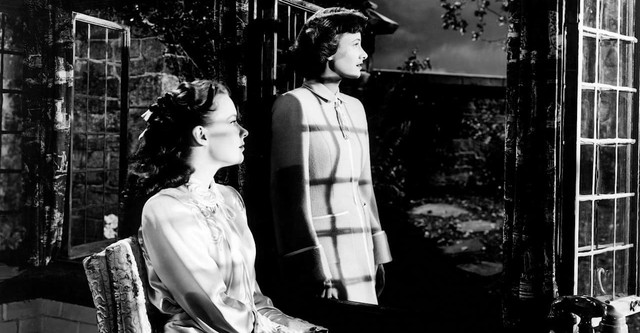As far as 1940s Hollywood was concerned, Cornwall was a death trap. Stray across its borders and you risked being menaced by ghosts (The Uninvited, 1944), terrorised by homicidal housekeepers (Rebecca, 1940) or trapped in a funhouse version of reality, doubting your own sanity (My Name is Julia Ross, 1945). In the opening minutes of The Sign of the Ram, the camera lingers on a picturesque railway poster for Cornwall. I began to prepare accordingly.
Sherida Binyon (Phyllis Thaxter) accepts a position as a secretary with the St. Aubyn family and goes to live with them at their estate on the Cornish coast. From the moment she crosses their threshold, it’s clear Mallory (Alexander Knox) and his children—Jane (Allene Roberts), Logan (Ross Ford) and Christine (Peggy Ann Garner)—are all exceedingly devoted to Leah (Susan Peters), Mallory’s wife and the children’s step-mother. Leah is their frequent, favourite topic of conversation and pleasing her their greatest joy. So much so that when Christine first meets Sherida she tells her she’s beautiful before bestowing an even greater compliment: “Leah will like that.”
Several years ago, Leah rushed into the sea to save two of her step-children from drowning. The injuries she sustained left her confined to a wheelchair, but she isn’t bitter. Instead she’s embarked on a successful career as a poet and writes sentimental odes to contentment. Serene and self-possessed—and so pale in the moonlight she might as well have been moulded from porcelain—Leah is a modern embodiment of Coventry Patmore’s ‘Angel in the House’: a paragon of womanly virtue.
It’s a relief when she also reveals herself to be dangerously possessive. Nothing must come between her and her adoring family: not friendships or marriage proposals or amiably bland secretaries who have the misfortune of being beautiful. The St. Aubyns belong to Leah alone.
Adapted from Margaret Ferguson’s novel of the same name, The Sign of the Ram leans towards the gothic end of the noir spectrum and crams in as many tropes as it can. Sherida is an ingénue in peril; the St. Aubyns’ past dominates their present; Bastions, the family estate, is centuries old; a nearby disused mine stands in for the obligatory ruins; shots of roiling waves crashing against rocks punctuate every other scene (some exteriors were filmed on location in Cornwall); and Burnett Guffey’s atmospheric cinematography does a lot of heavy lifting.
In fact, so does Susan Peters. As Leah, she brings depth to what is, essentially, a ‘wicked stepmother’ stereotype, creating a woman whose horror of abandonment magnifies her worst impulses, and who imposes her will while refusing to acknowledge her true feelings, even to herself.
Peters’ performance is even more impressive considering the path that led to it. She received an Oscar nomination for her work in Random Harvest (1942) and was on the cusp of stardom—MGM even promoted her from featured to star status in 1944—when she was injured in a hunting accident on New Year’s Day 1945. She was left paralyzed from the waist down but was determined to continue acting. The Sign of the Ram marked her return to the screen.
If only the film was worthy of her.
The plot is preposterous. Is Leah a master manipulator, or is everyone around her spectacularly foolish? Evidence suggests the latter, particularly the scene in which the family doctor (Ron Randell) detects her scheming and diagnoses the cause. Leah was born in April, under the titular sign of the ram, and she and her fellows, he tells her, “are endowed with a strong willpower and obstinacy of purpose”, as well as a desire to be obeyed. Yes, Leah is a maniac because she’s an Aries. Be sure to give every Aries in your acquaintance a wide berth. (The murder mystery When Were You Born (1938), in which Anna May Wong plays an astrologer who helps catch a killer, is proof this sort of high concept can work—if it’s handled with flair.) Either screenwriter Charles Bennett couldn’t fix flaws inherent in Ferguson’s novel, or he introduced absurdities of his own.
John Sturges’ direction also leaves much to be desired. There’s none of the precision you’d expect from the man who would go on to make Bad Day at Black Rock (1955) and The Great Escape (1963). The actors are all adrift save for Peters and Dame May Whitty (as a cheerfully venomous neighbour) and fatally for a gothic production, there’s no sense of dread.
Yet what really doomed The Sign of the Ram at the box office might have been bad luck. It was released the same year as Another Part of the Forest, Blanche Fury, The Big Clock, Hollow Triumph and a slew of other films that all did what it was trying to do and did it better. See it for Susan Peters’ performance, but don’t expect much else.

Leave a Reply